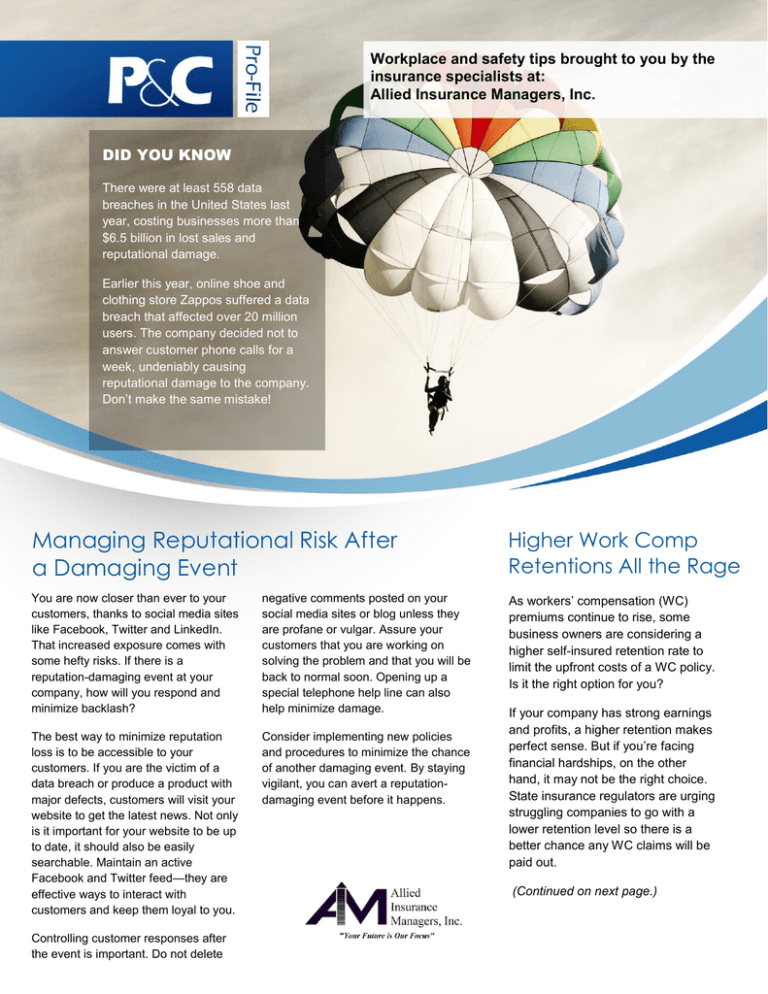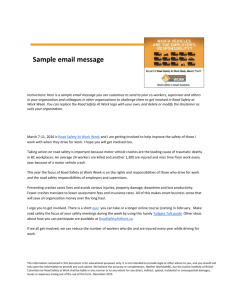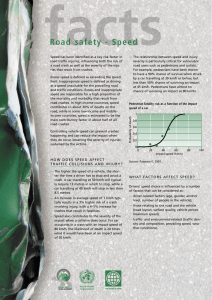
Workplace and safety tips brought to you by the
insurance specialists at:
Allied Insurance Managers, Inc.
DID YOU KNOW
There were at least 558 data
breaches in the United States last
year, costing businesses more than
$6.5 billion in lost sales and
reputational damage.
Earlier this year, online shoe and
clothing store Zappos suffered a data
breach that affected over 20 million
users. The company decided not to
answer customer phone calls for a
week, undeniably causing
reputational damage to the company.
Don’t make the same mistake!
Managing Reputational Risk After
a Damaging Event
Higher Work Comp
Retentions All the Rage
You are now closer than ever to your
customers, thanks to social media sites
like Facebook, Twitter and LinkedIn.
That increased exposure comes with
some hefty risks. If there is a
reputation-damaging event at your
company, how will you respond and
minimize backlash?
negative comments posted on your
social media sites or blog unless they
are profane or vulgar. Assure your
customers that you are working on
solving the problem and that you will be
back to normal soon. Opening up a
special telephone help line can also
help minimize damage.
As workers’ compensation (WC)
premiums continue to rise, some
business owners are considering a
higher self-insured retention rate to
limit the upfront costs of a WC policy.
Is it the right option for you?
The best way to minimize reputation
loss is to be accessible to your
customers. If you are the victim of a
data breach or produce a product with
major defects, customers will visit your
website to get the latest news. Not only
is it important for your website to be up
to date, it should also be easily
searchable. Maintain an active
Facebook and Twitter feed—they are
effective ways to interact with
customers and keep them loyal to you.
Consider implementing new policies
and procedures to minimize the chance
of another damaging event. By staying
vigilant, you can avert a reputationdamaging event before it happens.
Controlling customer responses after
the event is important. Do not delete
If your company has strong earnings
and profits, a higher retention makes
perfect sense. But if you’re facing
financial hardships, on the other
hand, it may not be the right choice.
State insurance regulators are urging
struggling companies to go with a
lower retention level so there is a
better chance any WC claims will be
paid out.
(Continued on next page.)
Stay Safe When Driving Company Car
Higher Retentions
Motor vehicle crashes are the leading cause of work-related death in the
United States. Risk of work-related motor vehicle crashes cuts across all
industries and occupations. Workers who drive on the job may be
“professional” drivers whose primary job is to transport freight or passengers,
and many other workers spend a substantial part of the work day driving a
vehicle owned or leased by their employer, or a personal vehicle.
(Continued from previous page.)
Thirty-five percent of occupational fatalities reported by the Bureau of Labor
Statistics are associated with motor vehicle crashes. Between 2003 and 2010,
on average:
1,275 workers died each year in crashes on public highways
311 workers died each year in crashes that occurred off the highway
or on industrial premises
338 pedestrian workers died each year as a result of being struck by a
motor vehicle
Over the same period, workers incurred nearly 400,000 lost-workday injuries
due to these incidents. Crash-related fatalities and serious injuries have a
devastating impact on workers and their families, and on the economic health
and productivity of American businesses.
For all workers who drive on the job, employer safety policies are a critical
element in reducing crash risks. Supporting and reinforcing state traffic laws is
a good start, but this alone does not adequately protect against the risks of
crashes and injuries. For example, not all states have made failure to use a
safety belt a primary offense, and few have banned the use of handheld cell
phones.
If you’re not sure which option is right
for your organization, conduct a
feasibility study. Estimate expected
costs and costs at different
retentions compared to typical
commercial coverage. WC claims are
generally easy to predict if you’re in
the manufacturing, construction or
health care industry, as there tends
not to be major fluctuations in cost
estimation.
A feasibility study may also help you
decide your retention rate. For
companies with strong financials that
are willing to take on risk, a higher
retention rate is suitable.
Experts are expecting WC policy
costs to rise in the near future, so the
time is now to review your current
WC policy and decide if any
adjustments need to be made.
For more resources about workers’
compensation policies, contact Allied
Insurance Managers, Inc. today.
By emphasizing defensive driving in company-owned vehicles, you can greatly
reduce commercial auto insurance costs; what’s more, employees may be able
to achieve savings on their personal auto insurance for undergoing a formal
defensive driving program. Consider implementing comprehensive policies and
programs to promote safe driving behaviors. Strong policies and training
ensure that work-related driving takes place under the safest possible
conditions, and that worker vehicles are safe and properly maintained.
Workplace and safety tips brought to you by the
insurance specialists at:
Allied Insurance Managers, Inc.
© 2012 Zywave, Inc. All rights reserved.




